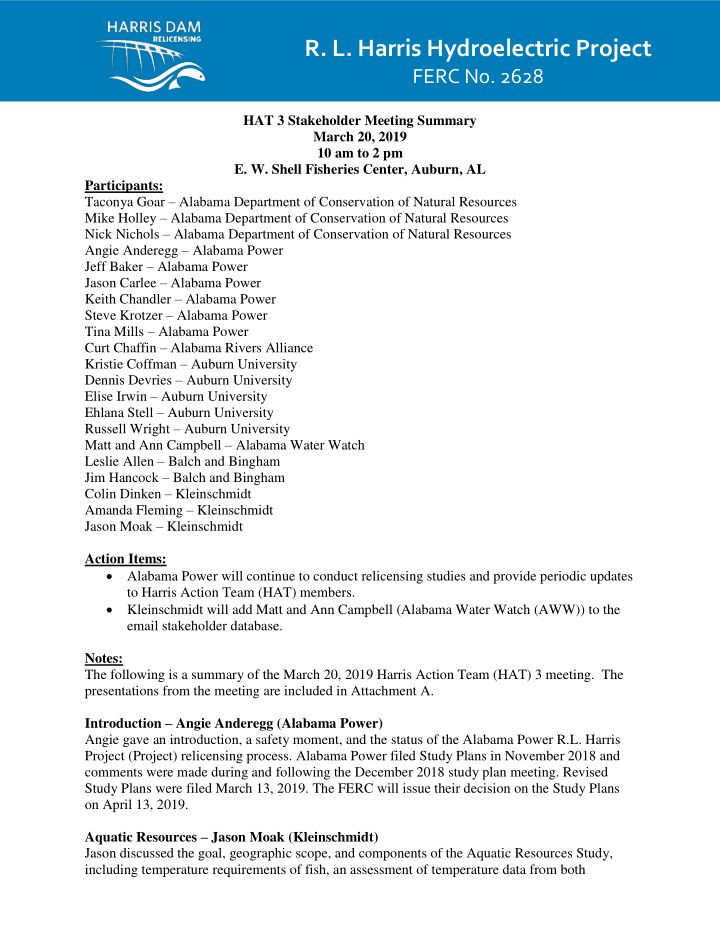



R. L. Harris Hydroelectric Project FERC No. 2628 HAT 3 Stakeholder Meeting Summary March 20, 2019 10 am to 2 pm E. W. Shell Fisheries Center, Auburn, AL Participants: Taconya Goar – Alabama Department of Conservation of Natural Resources Mike Holley – Alabama Department of Conservation of Natural Resources Nick Nichols – Alabama Department of Conservation of Natural Resources Angie Anderegg – Alabama Power Jeff Baker – Alabama Power Jason Carlee – Alabama Power Keith Chandler – Alabama Power Steve Krotzer – Alabama Power Tina Mills – Alabama Power Curt Chaffin – Alabama Rivers Alliance Kristie Coffman – Auburn University Dennis Devries – Auburn University Elise Irwin – Auburn University Ehlana Stell – Auburn University Russell Wright – Auburn University Matt and Ann Campbell – Alabama Water Watch Leslie Allen – Balch and Bingham Jim Hancock – Balch and Bingham Colin Dinken – Kleinschmidt Amanda Fleming – Kleinschmidt Jason Moak – Kleinschmidt Action Items: • Alabama Power will continue to conduct relicensing studies and provide periodic updates to Harris Action Team (HAT) members. • Kleinschmidt will add Matt and Ann Campbell (Alabama Water Watch (AWW)) to the email stakeholder database. Notes: The following is a summary of the March 20, 2019 Harris Action Team (HAT) 3 meeting. The presentations from the meeting are included in Attachment A. Introduction – Angie Anderegg (Alabama Power) Angie gave an introduction, a safety moment, and the status of the Alabama Power R.L. Harris Project (Project) relicensing process. Alabama Power filed Study Plans in November 2018 and comments were made during and following the December 2018 study plan meeting. Revised Study Plans were filed March 13, 2019. The FERC will issue their decision on the Study Plans on April 13, 2019. Aquatic Resources – Jason Moak (Kleinschmidt) Jason discussed the goal, geographic scope, and components of the Aquatic Resources Study, including temperature requirements of fish, an assessment of temperature data from both
regulated and unregulated reaches of the river, and fish community surveys by both wadeable (30+2 method) and boat-mounted methods. Jason explained that recent weather events and high flows have delayed field work, which will continue in the spring. Results of the 2017 and 2018 fish surveys at Heflin, Malone, and Wadley were similar to results reported over the past 14 years. The majority of specimens sampled were species of minnows and sunfish. Next, Jason explained that the Alabama Department of Environmental Management (ADEM) was looking to develop a standardized procedure for non-wadeable areas similar to the 30+2 method used in wadeable reaches. Jeff Baker (Alabama Power) noted that fish were sampled at Wadley and Horseshoe Bend using boat-mounted electrofishing in summer of 2018. Some species found in these areas are not typically seen in wadeable areas. Jason explained that Horseshoe Bend yielded twice as many fish as Wadley. Matt Campbell asked if dissolved oxygen or other water quality factors at Horseshoe Bend could have affected those results. Jason replied that it is hard to determine, as monitors are not present in these locations yet and these were individual sampling events; multiple sampling events may have reduced variation between the two sites. Aquatic Resources Study Continued – Dr. Dennis Devries, Dr. Russell Wright, and Ehlana Stell (Auburn University) Dr. Devries discussed the research objectives. The first objective is to review relevant research to determine temperature tolerances and limits of Redbreast Sunfish, Tallapoosa Bass, and Channel Catfish. Dr. Devries explained that there is little temperature data available for the Redbreast Sunfish and Tallapoosa Bass species; however, Spotted Bass data could possibly be used as surrogate data for Tallapoosa Bass. There is more temperature data available for Channel Catfish than Redbreast Sunfish and Tallapoosa Bass, but much of this is applied to pond settings, and may not be applicable to riverine habitat. Dr. Wright then explained bioenergetics and how temperature is involved. Many bioenergetic components are temperature dependent. Bioenergetics will be used in this study to assess the effects of Harris Dam operations on fish growth and stress. Dr. Wright explained the components of bioenergetics models and how results may be used in predicting growth. Dr. Wright explained the limitations to the bioenergetics model: (1) there is currently no model for Redbreast Sunfish or Tallapoosa Bass (although one could possibly be generated using similar species such as Bluegill Sunfish and Spotted Bass), (2) the current model for Channel Catfish is derived from pond systems instead of riverine systems, and (3) in the current model code, temperature and activity operate on a daily time step, so a model using a sub-daily timestep may be necessary. Ehlana described the temperature data provided by Alabama Power to Auburn University. Minimum, maximum, and mean temperature data were presented by location (tailrace, Malone, and Wadley) and compared pre- and post-Green Plan conditions from 2000-2019. Ehlana displayed histograms depicting daily temperature range (daily maximum – daily minimum) for each location and noted that the occurrence of daily temperature ranges of 10° C or greater was extremely rare. Jason explained that water is drawn into the forebay around 30 feet below the surface at full pool and may be pulled from shallower depths depending on the number of turbines that are running. Ehlana said that in winter, reservoir waters are not stratified and there would not be a large temperature difference between surface and deeper waters. Dr. Wright stated that presently, the temperature difference may be only a few degrees. Taconya Goar (Alabama Department of Conservation and Natural Resources (ADCNR)) stated that some variability may be missed when using daily data instead of hourly data. Dr. Wright said daily mean temperatures were calculated from hourly measurements, and the daily fluctuation were
Recommend
More recommend